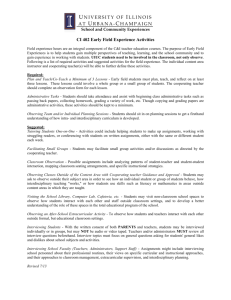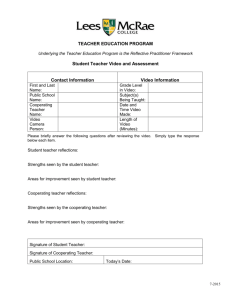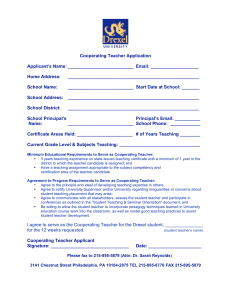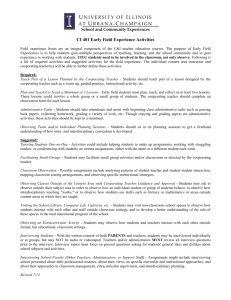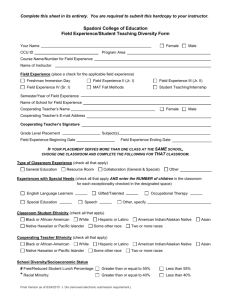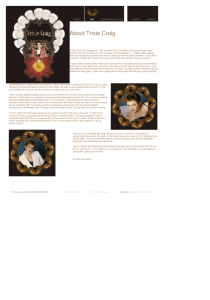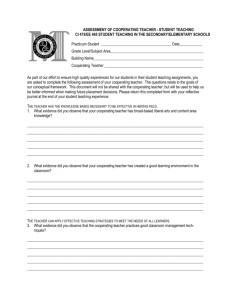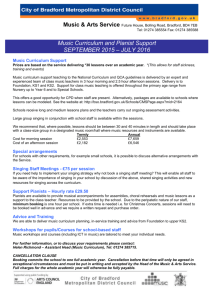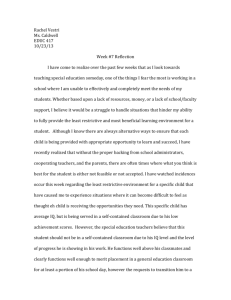Student Teaching in Music PowerPoint Presentation
advertisement
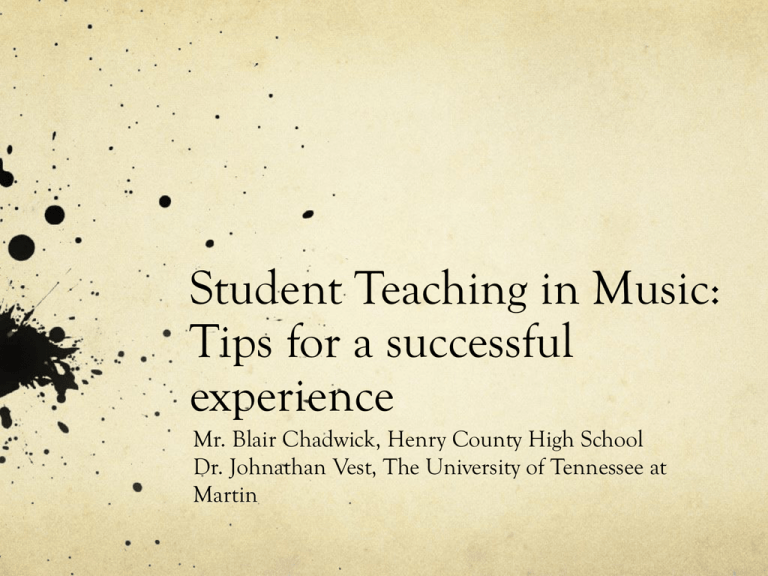
Student Teaching in Music: Tips for a successful experience Mr. Blair Chadwick, Henry County High School Dr. Johnathan Vest, The University of Tennessee at Martin The success of the student teaching experience depends on all its parts working correctly together. They include: • The Student Teacher • The Cooperating Teacher • The University Supervisor • The Students • The Administration and other teachers and personnel in the building The Basics • Punctuality Early=on time; On time=late; Late=FIRED • Dress and Appearance Be comfortable yet professional. Be aware of a dress code if one exists, as well as tattoos, piercings, and hair length (gentlemen.) • Parking/Checking-In Know this information BEFORE your first day • Materials and Paperwork Contact your CT BEFORE the first day. Know what you need and bring it with you on the first day. The Student Teacher Common Concerns • Will my cooperating teacher (CT) and school be a good fit for me? • Will I “crash and burn” my first time in front of the class? • What if my CT won’t let me teach? • What if my CT “throws me to the wolves” on the first day? • Will the students respect me? • How will I be graded? • Will I pass the Praxis?? How do I start? The student teaching experience can be divided into three parts: • Observing • Participating • Teaching. Observing Take copious notes, but don’t write down everything. Write down techniques, quotes, musical directions or teacher behaviors that seem important. Better yet, have a specific goal for the observation in mind before you begin. Don’t be overly critical of your CT during the observation process. Remember, they are the expert, you are the novice. Your perspective changes when you are in front of the class. Hand-write your notes. An electronic device, although convenient, is louder and can provide distraction for your CT, the students, and you. Write neatly so you can transcribe the notes later. An small audio recorder can be very useful in case you want to go back and hear something again. Participating Be attentive to the needs of the students and your CT, if you see a need that arises that the CT cannot or is not addressing, then take action. Don’t always wait to be told what to do. These situations may include: • Singing or playing with students who are struggling • Work with a section or small group of students • Helping a student with seat/written work • Attending to a a non-musical problem (student behavior, other student or CT needs.) Teaching Your US and your Student Teaching Office will probably instruct you on how much and when to teach, but each school and CT is different. In general, you should start teaching a class full time by week 3 and have at least two weeks of full-load teaching per placement. (This is not always possible.) Remember that any experience is good experience, so be grateful if you are asked to teacher early on in your experience. What the US is looking for during an observation The Lesson Plan Lesson organization (components, logical flow, pacing, time efficiency) Required components included National and State Standards Included—and these have/are changing!!!! Objectives stated in observable terms and tied directly to your assessment(s) What the US/CT is looking for during an observation Teaching Methods Questioning techniques (stimulate thought, higher order, open-ended, wait time) Appropriate terminology use Student activities instructionally effective Teacher monitoring of student activities, assisting, giving feedback Opportunities for higher order thinking Teacher energy/enthusiasm What the US/CT is looking for during an observation Classroom Management Media and materials are appropriate, interesting, organized and related to the unit of study. Teacher with-it-ness Student behavior management (consistency, classroom procedures in place, students understand expectations) What the US/CT is looking for during an observation Student Involvement/Interest/Participation in the Lesson Student verbal participation Balance of teacher talk/student talk Lots of “musicing” (singing, playing, listening, moving) Student motivation Student understanding of what to do and how to do it What the US is looking for during an observation Classroom Atmosphere Positive, can do atmosphere Student questions, teacher response Helpful feedback Verbal and non-verbal evidence that all students are accepted and feel that they belong Resources for Student Teachers A Field Guide to Student Teaching in Music, Ann C. Clements and Rita Klinger Teaching Music in the Urban Classroom, Carol FriersonCampbell, ed. Intelligent Music Teaching, Robert Duke
